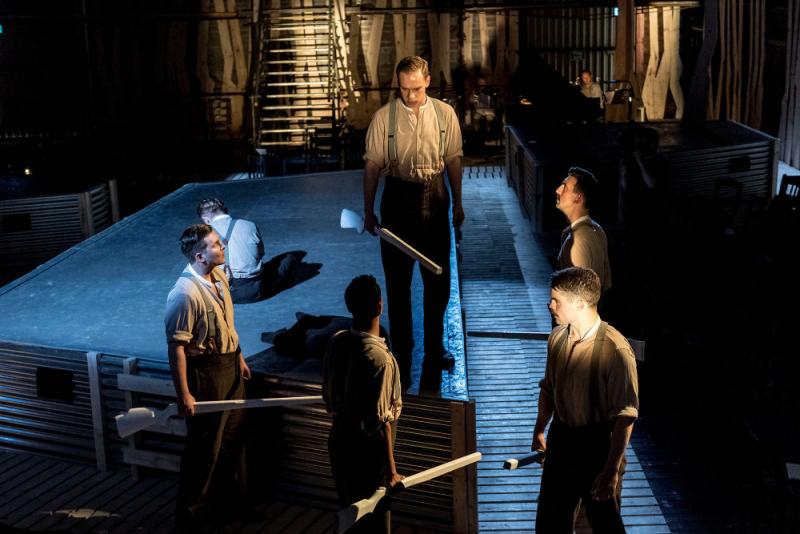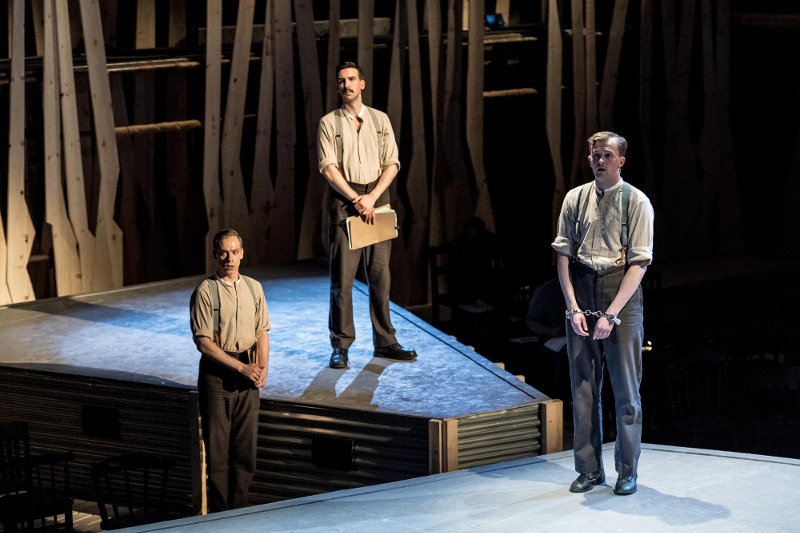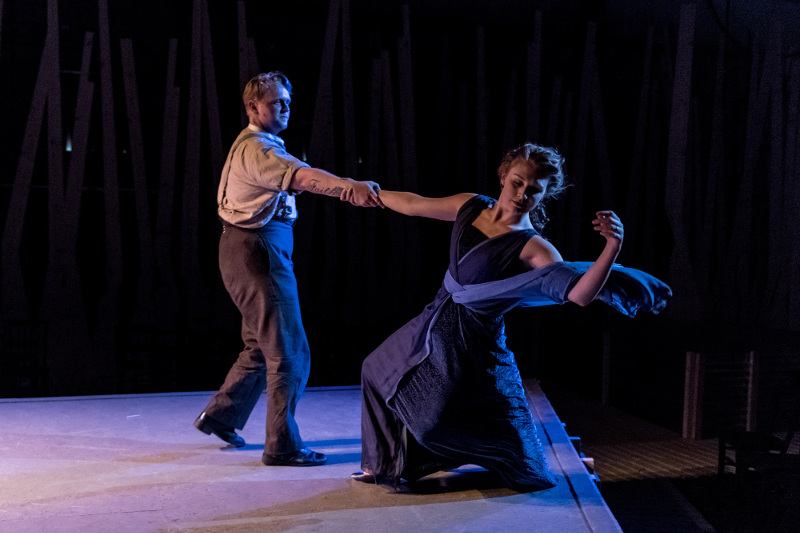The 306: Dawn, Dalcrue Farm, Perth | reviews, news & interviews
The 306: Dawn, Dalcrue Farm, Perth
The 306: Dawn, Dalcrue Farm, Perth
Sentimental World War One memorial from the National Theatre of Scotland

The journey begins amid the glassy modernity of Perth’s gleaming Concert Hall. From there, you’re bussed a few miles out into the Perthshire countryside to a blasted, burnt-out farmhouse. And its neighbouring barn, transformed into a forest of rifles and a maze of trenches for the National Theatre of Scotland’s sorrowful new World War One show The 306: Dawn.
One of the 14-18 NOW WW1 centenary art commissions, it’s also the NTS’s outgoing artistic director Laurie Samson’s final show with the company he has headed since 2013. And it’s nothing if not ambitious. Alongside its undeniably atmospheric location, The 306: Dawn weaves together a new script by Glasgow-based playwright Oliver Emanuel – whose young people’s show Dragon was a big hit at last year’s Edinburgh International Festival, and previously – and a brand new score by composer Gareth Williams, Scottish Opera’s composer in residence from 2011 to 2014.
It tells the true stories, dug up from archives, of three young Great War soldiers court martialled and executed by their own comrades for cowardice or desertion: cocky Londoner Harry Farr, left unable to fight by what we’d now call PTSD; Willie Stones, blamed for deserting his post while following his commander’s orders; and naive young Joe Byers from Glasgow, under-age when he volunteered and shot for seeking friendship away from the chaos of battle.
 To call the show site-specific, though, might be pushing things. The barn interior’s wide open space is an effective setting, and allows the action in Emanuel and Williams’s music/theatre hybrid to take place around and among the audience. But aside from staging logistics, it’s hard to see what the location specifically brings to the show or its themes, other than a frisson of authenticity for events that are unfolding in rural France.
To call the show site-specific, though, might be pushing things. The barn interior’s wide open space is an effective setting, and allows the action in Emanuel and Williams’s music/theatre hybrid to take place around and among the audience. But aside from staging logistics, it’s hard to see what the location specifically brings to the show or its themes, other than a frisson of authenticity for events that are unfolding in rural France.
There’s a similar issue with that hybrid format, too. It probably doesn’t matter whether we term it opera or musical theatre. But all the same, it falls uneasily between the two, both in style and in the way it melds music and text. And that music – there’s really quite a lot of it, as near-constant background mood-setting, or sudden eruptions of full-blown arias or torch songs. A lot of it is really quite similar, a Gavin Bryars- or Michael Nyman-tinged post-minimalism that, sumptuous and luminous though it is, often feels simply too bright, sometimes too energetic for the show’s dark themes. Less would probably have been more, on several levels. And on the odd occasion, Williams’s music simply gets in the way – not helped by the barn’s very resonant acoustic, which smears words and music together into a sometimes incomprehensible mess.
Despite the difficulties in sometimes hearing it, however, Emanuel’s writing is succinct and assured. He expertly pieces together the three men’s stories through flashbacks and memorable set-pieces – the chilling court martial of Willie Stones (a pragmatic, heavy-hearted Joshua Miles, pictured above with Steffan Lloyd-Jones and Joshua Manning), for example, or a dialogue at once touching and unsettling between the child-like Joe Byers (a wide-eyed Scott Gilmour) and Joshua Manning’s avuncular recruiting sargeant, who reluctantly admits him into the forces. Josef Davies stands out as foul-mouthed jack-the-lad Harry Farr reduced to a hallucinating, shaking wreck by shellshock, and the cast’s only woman, Emily Byrt (pictured below with Josef Davies), is hugely charismatic both acting and singing Farr’s wife Gertrude.
 Special mention, too, to the production’s three musicians from Glasgow’s Red Note Ensemble – cellist Robert Irvine, violinist Jackie Shave and pianist Jonathan Gill – who give a tireless, subtly nuanced performance of Williams’s score. Becky Minto’s wood-and-scaffold set, lit atmospherically by Simon Wilkinson with distant flashes and rumbles from battle, is evocative, but, despite the trenches weaving their way between the segmented audience, looks a bit too pristine to be a convincing battlefield location.
Special mention, too, to the production’s three musicians from Glasgow’s Red Note Ensemble – cellist Robert Irvine, violinist Jackie Shave and pianist Jonathan Gill – who give a tireless, subtly nuanced performance of Williams’s score. Becky Minto’s wood-and-scaffold set, lit atmospherically by Simon Wilkinson with distant flashes and rumbles from battle, is evocative, but, despite the trenches weaving their way between the segmented audience, looks a bit too pristine to be a convincing battlefield location.
In the end, though, it feels like the show could do with a harder edge overall. It does the memories of these three soldiers (and of the 303 others executed for similar reasons) enormous service in simply telling their stories, and bearing witness to their deaths. But it feels almost like a monument to sorrow, strangely unchanging in mood – especially as we know the inevitable outcome from the beginning. What never emerges is much sense of fury at the injustice, the senseless loss of life. It’s a harrowing, poignant, often unbearably moving production. But it seems more intent on wallowing in sorrow rather than exposing or challenging the reasons behind these killings by our own forces – and more importantly, asking what we can learn from them today.
Add comment
The future of Arts Journalism
You can stop theartsdesk.com closing!
We urgently need financing to survive. Our fundraising drive has thus far raised £49,000 but we need to reach £100,000 or we will be forced to close. Please contribute here: https://gofund.me/c3f6033d
And if you can forward this information to anyone who might assist, we’d be grateful.

Subscribe to theartsdesk.com
Thank you for continuing to read our work on theartsdesk.com. For unlimited access to every article in its entirety, including our archive of more than 15,000 pieces, we're asking for £5 per month or £40 per year. We feel it's a very good deal, and hope you do too.
To take a subscription now simply click here.
And if you're looking for that extra gift for a friend or family member, why not treat them to a theartsdesk.com gift subscription?
more Theatre
 The Billionaire Inside Your Head, Hampstead Theatre review - a map of a man with OCD
Will Lord's promising debut burdens a fine cast with too much dialogue
The Billionaire Inside Your Head, Hampstead Theatre review - a map of a man with OCD
Will Lord's promising debut burdens a fine cast with too much dialogue
 50 First Dates: The Musical, The Other Palace review - romcom turned musical
Date movie about repeating dates inspires date musical
50 First Dates: The Musical, The Other Palace review - romcom turned musical
Date movie about repeating dates inspires date musical
 Bacchae, National Theatre review - cheeky, uneven version of Euripides' tragedy
Indhu Rubasingham's tenure gets off to a bold, comic start
Bacchae, National Theatre review - cheeky, uneven version of Euripides' tragedy
Indhu Rubasingham's tenure gets off to a bold, comic start
 The Harder They Come, Stratford East review - still packs a punch, half a century on
Natey Jones and Madeline Charlemagne lead a perfectly realised adaptation of the seminal movie
The Harder They Come, Stratford East review - still packs a punch, half a century on
Natey Jones and Madeline Charlemagne lead a perfectly realised adaptation of the seminal movie
 The Weir, Harold Pinter Theatre review - evasive fantasy, bleak truth and possible community
Three outstanding performances in Conor McPherson’s atmospheric five-hander
The Weir, Harold Pinter Theatre review - evasive fantasy, bleak truth and possible community
Three outstanding performances in Conor McPherson’s atmospheric five-hander
 Dracula, Lyric Hammersmith review - hit-and-miss recasting of the familiar story as feminist diatribe
Morgan Lloyd Malcolm's version puts Mina Harkness centre-stage
Dracula, Lyric Hammersmith review - hit-and-miss recasting of the familiar story as feminist diatribe
Morgan Lloyd Malcolm's version puts Mina Harkness centre-stage
 Reunion, Kiln Theatre review - a stormy night in every sense
Beautifully acted, but desperately grim drama
Reunion, Kiln Theatre review - a stormy night in every sense
Beautifully acted, but desperately grim drama
 The Code, Southwark Playhouse Elephant review - superbly cast, resonant play about the price of fame in Hollywood
Tracie Bennett is outstanding as a ribald, riotous Tallulah Bankhead
The Code, Southwark Playhouse Elephant review - superbly cast, resonant play about the price of fame in Hollywood
Tracie Bennett is outstanding as a ribald, riotous Tallulah Bankhead
 The Lady from the Sea, Bridge Theatre review - flashes of brilliance
Simon Stone refashions Ibsen in his own high-octane image
The Lady from the Sea, Bridge Theatre review - flashes of brilliance
Simon Stone refashions Ibsen in his own high-octane image
 Romans: A Novel, Almeida Theatre review - a uniquely extraordinary work
Alice Birch’s wildly epic family drama is both mind-blowing and exasperating
Romans: A Novel, Almeida Theatre review - a uniquely extraordinary work
Alice Birch’s wildly epic family drama is both mind-blowing and exasperating

Comments
The story can't be
The story can't be effectively told if the reasons for the killings are to be challanged at the same time.